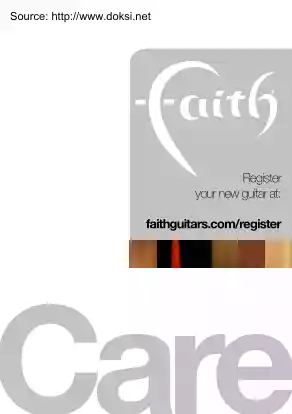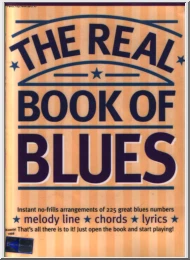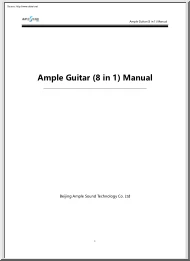A doksi online olvasásához kérlek jelentkezz be!

A doksi online olvasásához kérlek jelentkezz be!
Nincs még értékelés. Legyél Te az első!
Mit olvastak a többiek, ha ezzel végeztek?
Tartalmi kivonat
Source: http://www.doksinet Register your new guitar at: faithguitars.com/register Source: http://www.doksinet Care and Maintenance of your Faith Guitar Cleaning your Faith Guitar: The simplest way to keep your Faith Guitar clean is with a lint-free cloth. A regular wipe will keep dust and dirt at bay Guitar polish should be applied to lacquered areas only with a microfibre cloth. NB: Polish is not recommeded for unlacquered areas. Make sure to test the polish on a small, inconspicuous area first to check for any unexpected reaction between polish and lacquer. After every use, we recommend wiping the body and strings with a dry, lint-free cloth. Guitars with a light, satin finish - such as Faith Naked series - cannot be polished and due to the nature of the satin finish, they will mark and tarnish. Solvents sometimes found in plastics, leather or vinyl (used on accessories such as straps or stands) can also tarnish the lacquer over time, so keep a watch on any areas that start to
discolour. Perspiration can also tarnish the finish of your guitar as well as leave oily residue on the strings. Changing the Strings: Over time the strings on your Faith guitar will gradually become tarnished and lose their brilliance of tone. When this occurs, it’s time to fit a new set of strings. Faith Guitars are fitted as standard with coated strings (12-53 gauge). Coated strings such as Elixir or D’Addario EXP will offer a longer lifespan and increased brilliance. If you are fitting particularly heavy or extra light gauge strings, we strongly advise that you have the guitar checked out by 2 a qualified guitar-technician, as various adjustments may be required to ensure the neck responds accordingly. We recommend that you change all 6 strings at once. Changing only one string at a time can result in an unbalanced sound. How to Change Strings: Always loosen the strings before removing them. Do not cut them at tension. Remove the bridge pins using your fingers or a specially
designed ‘pin-puller’ available from your local music store. Acoustic guitar strings have a metal ball on one end and a plain end at the other. Once the bridge pin is removed, the metal ball end is to be placed into the appropriate hole in the bridge, and pushed through so that it is approximately an inch inside the body. Then the bridge pin is inserted back into the hole with the long groove facing toward the neck. Once the pin is partially re-inserted, hold the pin and pull the string through securing the ball end. The ball end is secured by the pin under the bridge plate. The bridge pin should be pushed back fully into place with a thumb or finger. Do not hammer or gule the pins into place. Humidity: Due to the solid wood nature of Faith instruments, climatic humidity is of great importance to the overall health of your guitar. Increases in humidity will cause the wood to take on more moisture from the surrounding air thus causing the wood to expand; and decreases in humidity
will result in moisture being lost from the wood and subsequently the wood shrinking. If these changes occur quickly, the tone woods may split 3 Source: http://www.doksinet or bow; the neck may move or twist unnaturally; or the glue may weaken causing problems with joints, bracing or bridge integrity. Every type or species of wood will expand or contract at different rates, as will the glues used in manufacturing. So, rapid changes in humidity - either up or down - are to be avoided at all costs. Humidity in the home: As mentioned previously, sudden changes in humidity and temperature are the cause of most issues, and these changes can come from unexpected places. Do not place your guitar near a radiator, fan heater or other source of ‘dry heat’. The air immediately surrounding the guitar will rapidly lose its moisture, and problems could occur. It is also advisable to avoid hanging your guitar on an outside wall inside your home. During particularly cold months, the temperature
and humidity acting on the back of the guitar will differ from the front. If your guitar is exposed to freezing temperatures, once taken indoors, we advise that you leave it in its case to reach room temperature more slowly. This should lower the chances of cracks appearing in the wood or lacquer. Adjusting the action of your guitar: We advise that you seek professional advice from a Guitar Technician before adjusting the action of your guitar. Incorrect adjustments may permanently damage your instrument. Do not adjust the neck truss rod without a full knowledge of the implications. There is an Allen Key included in your Faith Guitar case if you do wish to 4 make adjustments however. With the headstock facing away from you, turning the Allen key clockwise will tighten the truss rod, reducing the neck relief (straightening the neck) and conversely turning the Allen key anticlockwise will loosen the truss rod, increasing the neck relief (allowing more neck bow). The truss rod should be
adjusted no more than one quarter turn at once, after which a few minutes should be allowed for the neck wood to readjust itself before further adjustment. However, adjusting the neck truss rod is not an easy fix for a high string action. See your local guitar technician for a full diagnosis of the cause of any unduly high string action. Most guitars need to have a slight concave bow to the neck. A dead straight, flat neck is rarely the ideal setup. Care of your guitar whilst travelling: Whether you’re taking your Faith guitar on the school bus or the tour bus, don’t forget that your instrument is more than just another piece of baggage. Ideally, when travelling in a car, your guitar is best placed in its case on the back seat. The boot (trunk) of a car is susceptible to greater fluctuations in temperature and is rarely ventilated properly. When travelling by aeroplane, we would advise the use of a specific flightcase for your guitar. These are often made of ABS plastic or
aluminium, and offer the maximum level of protection for your instrument. When possible, ask for your guitar to be hand-carried to the aircraft rather than via baggage conveyor, and then hand collected by you from the gate upon landing. Not all airlines offer this service however. When the instrument is travelling in the aircraft hold, it is advised to loosen the strings and keep the instrument as tight inside the case as possible. 5 Source: http://www.doksinet In Summary: 6 • After every use, wipe your guitar with a clean, lint-free cloth. • Test any polish used on a small area before applying to the whole guitar. • The use of Lemon Oil or similar is recommended for nourishing the fingerboard wood. • Change all 6 strings at once for the best results. • Have your guitar checked by a Guitar Tech if you are fitting very heavy or very light gauge strings. • Do not place your guitar near sources of dry heat such as radiators or fan heaters. • Do not rest your
guitar against its own neck. • Do not hang your guitar against an outside wall in the home during cold weather. • When you have finished playing, it is recommended that your guitar is placed back into its hard case. • Do not adjust the neck truss rod unless you are completely confident in doing so. • When travelling by car, it is best to take your guitar in the back seat of the car rather than placing it in the boot (trunk). • When travelling by air, it is advised that you use an ABS flightcase and if possible, carry it in the passenger compartment. • When using an electro-acoustic guitar, you must remove the cable from the jack socket when you have finished playing, otherwise the battery will still be engaged and will therefore lose power very quickly. • The battery light on the preamp will only show when the battery is about to expire. • You can find more detailed information at www.faithguitarscom 7 Source: http://www.doksinet Register your
guitar: www.faithguitarscom/register Send us pictures, videos and your Faith Guitar experiences: On Facebook: facebook.com/faithguitars On Twitter: twitter.com/faithguitars On YouTube: youtube.com/faithguitars On the Web: faithguitars.com 8 ‘Faith Guitars’, ‘Faith’ and the Faith Guitars logo are registered trademarks of Barnes & Mullins Ltd, United Kindgom. wwwbarnesandmullinscouk
discolour. Perspiration can also tarnish the finish of your guitar as well as leave oily residue on the strings. Changing the Strings: Over time the strings on your Faith guitar will gradually become tarnished and lose their brilliance of tone. When this occurs, it’s time to fit a new set of strings. Faith Guitars are fitted as standard with coated strings (12-53 gauge). Coated strings such as Elixir or D’Addario EXP will offer a longer lifespan and increased brilliance. If you are fitting particularly heavy or extra light gauge strings, we strongly advise that you have the guitar checked out by 2 a qualified guitar-technician, as various adjustments may be required to ensure the neck responds accordingly. We recommend that you change all 6 strings at once. Changing only one string at a time can result in an unbalanced sound. How to Change Strings: Always loosen the strings before removing them. Do not cut them at tension. Remove the bridge pins using your fingers or a specially
designed ‘pin-puller’ available from your local music store. Acoustic guitar strings have a metal ball on one end and a plain end at the other. Once the bridge pin is removed, the metal ball end is to be placed into the appropriate hole in the bridge, and pushed through so that it is approximately an inch inside the body. Then the bridge pin is inserted back into the hole with the long groove facing toward the neck. Once the pin is partially re-inserted, hold the pin and pull the string through securing the ball end. The ball end is secured by the pin under the bridge plate. The bridge pin should be pushed back fully into place with a thumb or finger. Do not hammer or gule the pins into place. Humidity: Due to the solid wood nature of Faith instruments, climatic humidity is of great importance to the overall health of your guitar. Increases in humidity will cause the wood to take on more moisture from the surrounding air thus causing the wood to expand; and decreases in humidity
will result in moisture being lost from the wood and subsequently the wood shrinking. If these changes occur quickly, the tone woods may split 3 Source: http://www.doksinet or bow; the neck may move or twist unnaturally; or the glue may weaken causing problems with joints, bracing or bridge integrity. Every type or species of wood will expand or contract at different rates, as will the glues used in manufacturing. So, rapid changes in humidity - either up or down - are to be avoided at all costs. Humidity in the home: As mentioned previously, sudden changes in humidity and temperature are the cause of most issues, and these changes can come from unexpected places. Do not place your guitar near a radiator, fan heater or other source of ‘dry heat’. The air immediately surrounding the guitar will rapidly lose its moisture, and problems could occur. It is also advisable to avoid hanging your guitar on an outside wall inside your home. During particularly cold months, the temperature
and humidity acting on the back of the guitar will differ from the front. If your guitar is exposed to freezing temperatures, once taken indoors, we advise that you leave it in its case to reach room temperature more slowly. This should lower the chances of cracks appearing in the wood or lacquer. Adjusting the action of your guitar: We advise that you seek professional advice from a Guitar Technician before adjusting the action of your guitar. Incorrect adjustments may permanently damage your instrument. Do not adjust the neck truss rod without a full knowledge of the implications. There is an Allen Key included in your Faith Guitar case if you do wish to 4 make adjustments however. With the headstock facing away from you, turning the Allen key clockwise will tighten the truss rod, reducing the neck relief (straightening the neck) and conversely turning the Allen key anticlockwise will loosen the truss rod, increasing the neck relief (allowing more neck bow). The truss rod should be
adjusted no more than one quarter turn at once, after which a few minutes should be allowed for the neck wood to readjust itself before further adjustment. However, adjusting the neck truss rod is not an easy fix for a high string action. See your local guitar technician for a full diagnosis of the cause of any unduly high string action. Most guitars need to have a slight concave bow to the neck. A dead straight, flat neck is rarely the ideal setup. Care of your guitar whilst travelling: Whether you’re taking your Faith guitar on the school bus or the tour bus, don’t forget that your instrument is more than just another piece of baggage. Ideally, when travelling in a car, your guitar is best placed in its case on the back seat. The boot (trunk) of a car is susceptible to greater fluctuations in temperature and is rarely ventilated properly. When travelling by aeroplane, we would advise the use of a specific flightcase for your guitar. These are often made of ABS plastic or
aluminium, and offer the maximum level of protection for your instrument. When possible, ask for your guitar to be hand-carried to the aircraft rather than via baggage conveyor, and then hand collected by you from the gate upon landing. Not all airlines offer this service however. When the instrument is travelling in the aircraft hold, it is advised to loosen the strings and keep the instrument as tight inside the case as possible. 5 Source: http://www.doksinet In Summary: 6 • After every use, wipe your guitar with a clean, lint-free cloth. • Test any polish used on a small area before applying to the whole guitar. • The use of Lemon Oil or similar is recommended for nourishing the fingerboard wood. • Change all 6 strings at once for the best results. • Have your guitar checked by a Guitar Tech if you are fitting very heavy or very light gauge strings. • Do not place your guitar near sources of dry heat such as radiators or fan heaters. • Do not rest your
guitar against its own neck. • Do not hang your guitar against an outside wall in the home during cold weather. • When you have finished playing, it is recommended that your guitar is placed back into its hard case. • Do not adjust the neck truss rod unless you are completely confident in doing so. • When travelling by car, it is best to take your guitar in the back seat of the car rather than placing it in the boot (trunk). • When travelling by air, it is advised that you use an ABS flightcase and if possible, carry it in the passenger compartment. • When using an electro-acoustic guitar, you must remove the cable from the jack socket when you have finished playing, otherwise the battery will still be engaged and will therefore lose power very quickly. • The battery light on the preamp will only show when the battery is about to expire. • You can find more detailed information at www.faithguitarscom 7 Source: http://www.doksinet Register your
guitar: www.faithguitarscom/register Send us pictures, videos and your Faith Guitar experiences: On Facebook: facebook.com/faithguitars On Twitter: twitter.com/faithguitars On YouTube: youtube.com/faithguitars On the Web: faithguitars.com 8 ‘Faith Guitars’, ‘Faith’ and the Faith Guitars logo are registered trademarks of Barnes & Mullins Ltd, United Kindgom. wwwbarnesandmullinscouk




 Ahogy közeledik a történelem érettségi, sokan döbbennek rá, hogy nem készültek fel eléggé az esszéírás feladatra. Módszertani útmutatónkban kitérünk a történet térbeli és időbeli elhelyezésére, a források elemzésére és az eseményeket alakító tényezőkre is.
Ahogy közeledik a történelem érettségi, sokan döbbennek rá, hogy nem készültek fel eléggé az esszéírás feladatra. Módszertani útmutatónkban kitérünk a történet térbeli és időbeli elhelyezésére, a források elemzésére és az eseményeket alakító tényezőkre is.